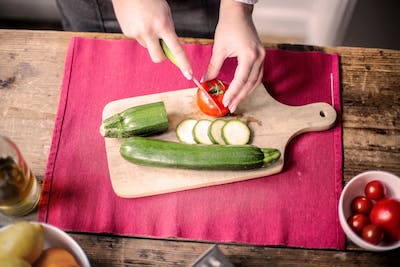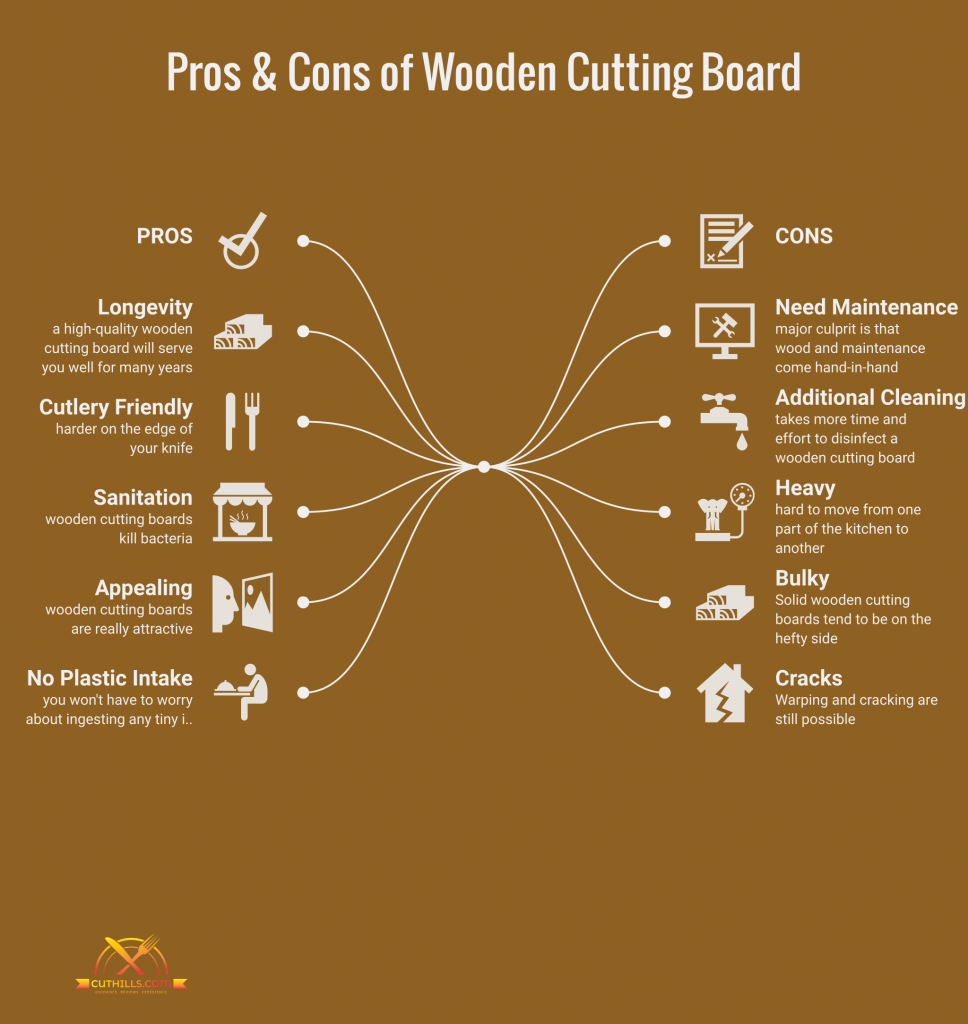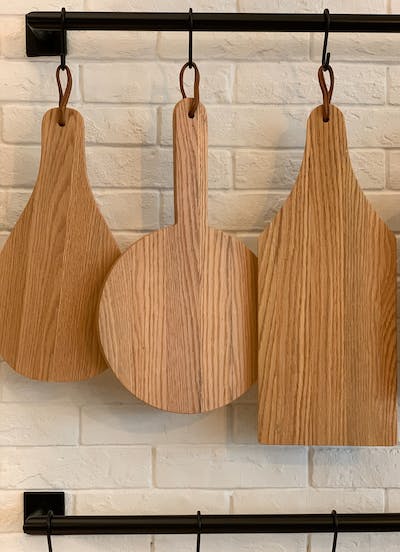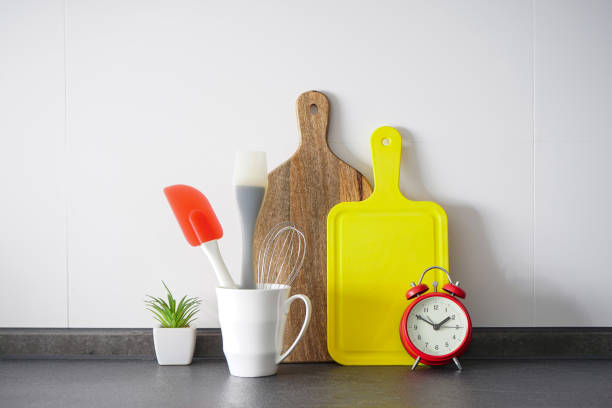Our prehistoric culinary forebears probably used what they had on hand as they chopped a solid tree log into the first cutting board. It turns out that the resources they already had on hand made the best cutting boards possible. Of course, you may also consider the alternatives, but why are wood cutting boards better? Since then, new materials have been created for use in the kitchen, with plastic becoming the most frequent.
However, when it comes to chopping and dicing food, wooden cutting boards still reign supreme. This is why we opted to manufacture our own wooden chopping blocks. Find out why this organic substance is still superior to other options by reading on.
Quick Tips for Maintaining Kitchen Hygiene and Preventing Food Poisoning
- Use plenty of times to wash your hands in hot water with some non-toxic soap. Antibacterial products containing triclosan, which degrades into dioxin in the environment, are unnecessary.
- Surfaces can be disinfected effectively with hot, soapy water, hydrogen peroxide spray, and white vinegar spray, or with these two cleaners used in combination.
- To that end, sponges should be avoided. As a result, bacteria thrive in the constant moisture they provide.
- Avoid exposing different parts of the system to contamination. Separate raw meat from uncooked vegetables, cooked food from raw, etc. Keep the cooked meat on a separate platter from the raw meat during grilling.
- Pick the healthiest options available. Good bacteria are harder to find in the meat and eggs of healthy animals. If the food was cultivated or farmed by you or anyone you know, there is less possibility of contamination.
Key Characteristics of Cutting Boards

Use a wooden or bamboo cutting board to protect your investment in your blades. Cutting boards made of porous softwood or “open-grain” hardwood are preferable to glass ones when it comes to your pricey knives. This is due to the fact that they can be lubricated without causing any damage. There are numerous ways in which bamboo and wooden cutting boards differ from one another.
Getting familiar with the features of both bamboo and wooden cutting boards is helpful before making any comparisons about the materials used or the practicality of each. Cutting boards made of wood and bamboo can be compared in terms of hardness, porosity, and toxicity, despite their differences.
Why Wood?
Imagine a clean, shiny countertop when you think about kitchen chores, the polished steel of a go-to frying pan, and the transparent glass of a trusted mixing bowl. Wood isn’t something you’d usually find in a kitchen because it has a rough surface and pores. But it is true. That is, what occurs when one hard substance meets another? There will be clinking, chipping, and breaking.
Kitchen tools like pots, pans, and knives see the most usage and wear, so they need to be sturdy enough to withstand regular use. Nonetheless, these should soften whatever they touch. The best material for a knife’s handle would be something solid but flexible, like wood, so that it can be used often without getting dull.
Wood Cutting Boards: Pros and Cons
Even though they are often used in the kitchen, wooden cutting boards are useful in many other ways as well. They make a bold statement. Sizes and designs range from hefty butcher’s blocks to delicate cheese platters.

The Pros
1-Longevity of Wooden Cutting Boards
Maybe not forever, but a high-quality wooden cutting board will serve you well for many years. If you scratch the board badly enough, you can usually fix it by sanding it. Artificial materials rarely have such a high tolerance for wear and tear.
2-Friendly to Cutlery
Hardwoods like rattan and plastics are much harder on the edge of your knife than maple and walnut, which are two types of wood used to make cutting boards. Cutting on a wooden board, especially one made of maple or walnut, is a pleasant experience. Both of them are considered hardwoods. However, unlike bamboo, they are much easier on your knives.
3-Sanitation
Some people don’t like wood because it’s porous and tends to soak up liquids, which makes it a good place for bacteria to grow. However, several scientific investigations have proven the opposite to be true.
Wooden Cutting Boards Kill Bacteria
Plastic looks like it can’t be broken at first glance, but its surface quickly shows knife marks when it’s used every day. You can’t even use bleach or the dishwasher to get rid of the grime on this hard surface. On the other hand, it has been shown that wood can stop bacteria from growing and even kill them if it comes into contact with its surface. This ability is retained by both new and old hardwood cutting boards.
The porous nature of wooden boards has led some to worry that they may be unsanitary. However, research has actually revealed the inverse to be true. A study found that after bacteria get on wood, the wood can absorb them and kill them in 3–10 minutes. Fatty pollutants, such as raw chicken fat, could linger on the panel for hours, posing a health danger to everyone who touches it. Yet, any bacteria may be washed away with a fast wash in warm, soapy water.
A Comparison of Wood to Common Pathogens Like Salmonella, Listeria, and E. coli
Salmonella, Listeria, and enterohemorrhagic Escherichia coli, all of which are known to cause food poisoning, were all looked at in research done at the University of Wisconsin. In this test, bacteria were put on cutting boards made from seven different kinds of wood and four different kinds of plastic. Wooden planks have always surpassed their plastic counterparts.
The Ability of Bacteria to Persist on Plastic and Wood Fibers
It was found that pine and oak sawdust was the best at getting rid of bacteria. The investigation shows that the hygroscopic properties of wood and the effect of wood extractives together have an antibacterial effect, and both pine and oak are much cleaner than plastic.
4-Appealing to the Eye
A cutting board made of wood is really attractive. We wouldn’t be truthful if we said it wasn’t essential to us, but it probably isn’t the most important thing to look for when filling your kitchen, and it certainly doesn’t outweigh any big issues. As the saying goes, first impressions are lasting ones, so it stands to reason that we would all like to have kitchens that we enjoy spending time in
5-You’re Not Consuming Tiny Amounts of Plastic
If you choose wood instead of plastic, you won’t have to worry about ingesting any tiny pieces. You can tell whether your cutting board is made of plastic because it will have nicks in it from where the knife was used.
The Cons
1-Moderate Maintenance Needed
The major culprit is that wood and maintenance come hand-in-hand. Because it is made of natural materials, it often needs to be conditioned with mineral oil made for food to keep it from drying out, warping, and cracking. Boards treated with food-grade oil are more resistant to drying out, cracking, and warping. A second benefit of oiling your boards is that it keeps them from absorbing water.
However, hardwood cutting boards are not invincible, even with maintenance. Warping and cracking are still possible, especially near the joints where the wood pieces were joined. To avoid this problem, it’s recommended to start with high-quality wood cutting boards.
2-Additional Cleaning Efforts
It takes more time and effort to disinfect a wooden cutting board than a plastic one. Don’t place them in the washer, and don’t soak them either; the board won’t last long in those conditions. If you leave your board exposed to the elements for too long, it will deteriorate.
Cleaning your wooden cutting board is as simple as washing it in warm, soapy water, rinsing it, and setting it out to dry. Then, use wood seasoning oil to clean the board. This is the proper way to care for a hardwood cutting board so that it lasts for generations.
3-Bulky and Unwieldy
Solid wooden cutting boards tend to be on the hefty side. Ones that are thinner and lighter in weight are more likely to warp, so we don’t advise using them. Still, there’s no getting around the fact that the heavier ones we suggest are hard to move from one part of the kitchen to another. Wooden cutting boards can be hard to move, so people who have trouble moving around may want to look elsewhere.
The Best Woods for a Cutting Board
Taking into account the aforementioned factors, we have selected the top woods for cutting boards. Compare them down below.

Maple
In terms of its usefulness as a cutting surface, maple can be used in either its soft or hard forms. But the gold standard for cutting boards is firm maple. It’s harder than beech, teak, and walnut, but not so hard that it’ll dull your blades, and it’s highly scratch- and impact-resistant. This closed-grained, food-safe hardwood has smaller pores than the alternatives below, which makes it better at resisting germs, moisture, and stains.
When stains do appear on its surface, however, they stand out starkly against the neutral to warm yellow color. In addition to being more expensive than beech (anything from $20 to $150), birch cutting boards and chopping blocks shrink more dramatically than oak and walnut when exposed to dry air.
Beech
This close-grained hardwood has a hardness of 1,300 lbf, which means it won’t harm blades and has excellent resistance to scratches and impacts, second only to hard maple. Because wood has tight pores, it resists germs, dampness, and stains almost as well as maple (and better than teak and walnut).
However, the light cream, pink, or brown hues of this wood make it more susceptible to staining than dark hardwoods like teak and walnut. Even though they cost the least (usually between $15 and $100), these cutting surfaces shrink the most, so they should be conditioned once a month.
Teak
Teak is more resistant to wear and tear than walnut and beech, but not as much as maple and beech, thanks to its toughness rating of 1,070 lbf. It is a tropical hardwood that is tightly sealed and costs the most (between $25 and $500). If you cut on a teak cutting board a lot, your knife blade may become dull.
As teak shrinks the least, it may go between four and eight months without being conditioned, while the other three woods used for cutting boards all require quarterly or biannual maintenance. It may seem like walnut, maple, or beech, but its wide pores make it more susceptible to bacteria, dampness, and stains. The reddish to dark brown color of the nutrition wood hides spills and smudges better than maple but not as effectively as walnut.
Walnut
Walnut, the least hard of the four closed-grained hardwoods, will not dull knife blades but is more easily scratched or dented than the other woods because of its lower hardness value of 1,010 lbf. This food-safe wood has less resilience to germs and moisture than maple or beech due to its medium-to-large pores.
And unlike maple or beech, it only needs to be conditioned every two to four months. Also, the wood’s dark chocolate color hides common stains and gives it a high-end look, which is reflected in its higher price range of $20–200.
Wood vs. Plastic

Plastic cutting boards have several advantages over wooden ones. They are lighter, cheaper, and come in a wider range of colors. They are also easy to clean and sanitize because both HDPE and PVA can stand up to most food-safe cleaning solutions, long soaking times, and many cycles of dishwashing.
Wood vs. Rubber
Rubber can be made to look and feel like wood, right down to being hefty and long-lasting but still soft enough to keep a knife’s edge. There is evidence that this material also has self-healing qualities. Rubber cutting boards are durable, resistant to most food-safe cleaning techniques, and frequently dishwasher-safe.
Wood vs. Bamboo
Bamboo is not hardwood, as most people think. Instead, it is very tough grass. It’s about as hard as walnut and as porous as maple, making it an exceptional hardwood. Bamboo has a Janka hardness rating of 1,380, while walnut rates 1,010, and maple clocks in at 1,450.
Wood vs. Glass or Marble
If you or someone you know has ever tried to cut on a marble or glass surface, you know that these are not ideal materials for use as cutting boards. If your knife is making an annoying clicking noise, it is probably getting duller with each cut. On top of that, you risk cutting yourself or losing your grip because of the smooth surface when moving a heavy marble cutting board from the cupboard to the work surface. Forget it.
Frequently Asked Questions:
Q: Do you recommend bamboo cutting boards?
The eco-friendliness of bamboo makes it an ideal material for cutting boards used in the kitchen. You may wish to suggest buying a couple extra pieces because they aren’t as sturdy as regular cutting boards. Invest in a good cutting board if you plan on preparing a lot of raw beef, fish, or poultry. Don’t forget that splinters and wounds can be quite painful if you ignore this warning.
Q. What about cutting boards made of glass?
Preparing food on a glass cutting board is not recommended due to the board’s slippery surface and the negative effects it has on knives. Even though they are attractive, you shouldn’t use them in the kitchen.
They only serve as display and for serving. People like them because they can be safely cleaned in the dishwasher. However, if you value dishwasher safety, you have better options, such as plastic or Epicurean boards.
Q. How come it’s so crucial to have a spotless cutting board?
Bacteria grow quickly on dirty surfaces, which is why it’s very important to use a clean cutting board. If you don’t want to get sick or have your food go bad, you need to make sure your cutting board is spotless. Using a sanitary cutting board also helps avoid the spread of germs. The bacteria from raw meat could spread to your produce if you cut it on an unclean cutting board. As such, make sure your cutting board is spotless at all times!
Q. Do you think plastic cutting boards or wooden ones offer more sanitation?
Wood can’t support the growth of microorganisms and bacteria because of how it was made. The fact that the board may be sealed with wax makes it safer than plastic; just be sure to choose a wax that is appropriate for use with food. However, knife cuts in plastic can become breeding grounds for germs. Wood has these qualities, making it a better material choice than plastic.
Q. How come cutting boards made of wood are risk-free to use?
Cedar and cypress, which are natural parts of wood, make wooden cutting boards safer than plastic ones. Bacteria have a hard time taking hold on these materials, and they’re also simple to disinfect. When it comes to durability and robustness, wooden cutting boards are the best. It is possible to fix, refinish, and restore a wooden cutting board after it has been damaged. However, once a plastic cutting board is destroyed, it must be replaced permanently.
Q. Do knives cut through plastic cutting boards?
Scratching is a common problem with several plastics, especially the thinner varieties. Deep knife marks on a plastic chopping board can damage the board and provide a place for bacteria to grow. Also, they can’t be wiped out of nature altogether.
Likewise, your knife will become dull more quickly on a plastic surface than it would on wood. Therefore, walnut, cherry, or maple hardwoods provide for the finest boards. Those hardwoods are preferred over softer ones like pine.
Q: Can bacteria thrive within a wooden cutting board?
Cutting boards, whether made of wood or plastic, have been found to host dangerous microorganisms in investigations. Many individuals feel safer using wooden cutting boards, but this does not negate the need to keep them clean. Cutting boards should be cleaned following each use and stored in a dry place, out of reach of food, to ensure a hygienic kitchen.
Final Thoughts
The Food and Drug Administration recommends that people feel secure using either plastic or wood as long as they follow proper maintenance instructions. This article shows, however, that plastic is far more dangerous due to the presence of bacteria that is difficult to remove from scars. Wood naturally stops bacteria from growing because it soaks up water and then slowly lets it out. Considering that plastic boards can take hundreds of years to break down and can cause the release of microplastics, I find wood to be a much better option for a cutting board.
